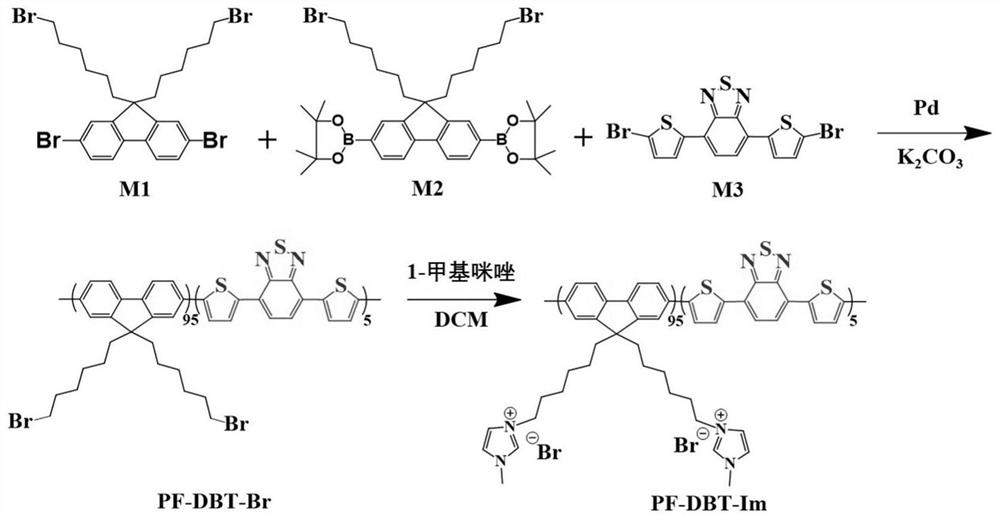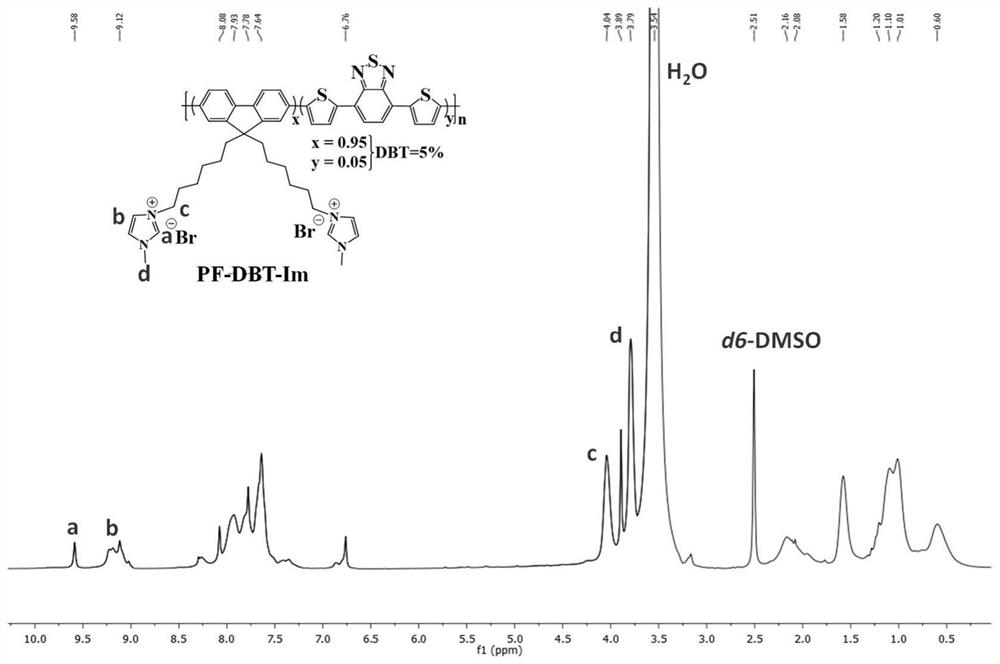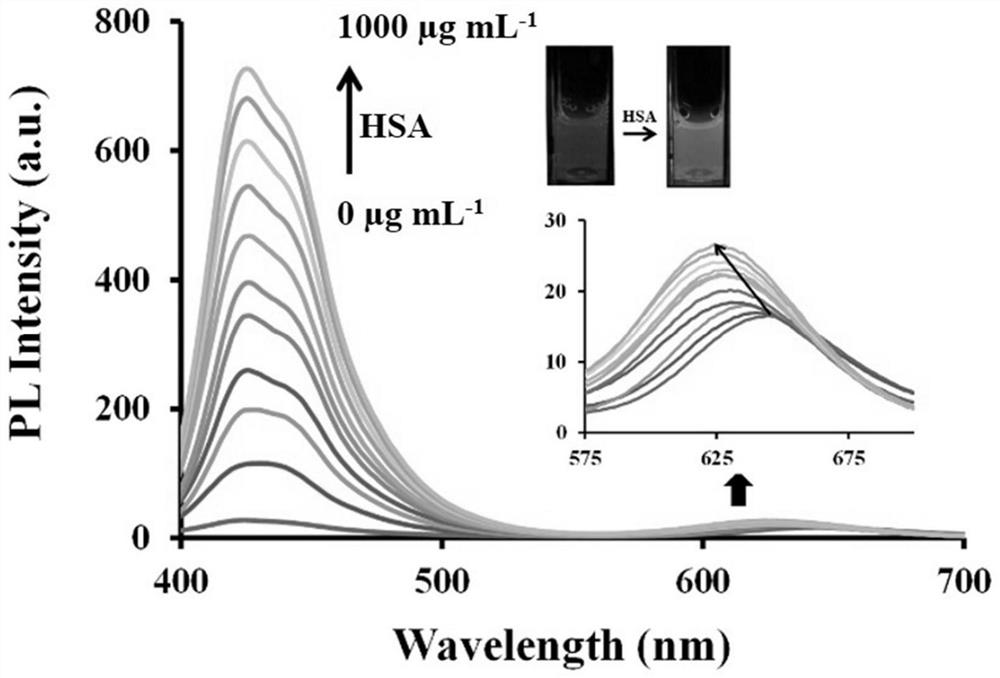A cationic conjugated polymer and ratiometric fluorescent probe based thereon, preparation method and application
A conjugated polymer, fluorescent probe technology, applied in the field of fluorescent probes, can solve problems such as poor selectivity
- Summary
- Abstract
- Description
- Claims
- Application Information
AI Technical Summary
Problems solved by technology
Method used
Image
Examples
Embodiment 1
[0034] Take 0.1g of 2,7-dibromo-9,9-bis(6-bromohexyl)fluorene (M1), 0.1g of 2,7-bis(4,4,5,5-tetramethyl-1, 3,2-dioxaboran-2-yl)-9,9-bis(6-bromoethyl)fluorene (M2), 0.1 g of 4,7-bis(5-bromothiophen-2-yl) Benzo[c][1,2,5]thiadiazole (M3) was placed in a three-necked flask, and 25 mL of tetrahydrofuran solution was added to obtain solution 1; 0.5 g of potassium carbonate was mixed with 1 mL of ultrapure water, and added to solution 1 with a syringe , degassed for 30min, added 0.005g of tetrakis (triphenylphosphine) palladium as catalyst, passed nitrogen for 30min, heated and refluxed at 45°C for 6h to carry out the polymerization reaction; after the polymerization reaction, remove the organic solvent with a rotary evaporator, add water and Extraction with dichloromethane, taking the organic phase, drying with anhydrous sodium sulfate, filtering; removing the organic solvent by rotary evaporation to obtain the precursor polymer PF-DBT-Br. After mixing 10 mg of PF-DBT-Br, 1 mL of 1...
Embodiment 2
[0037] Take 0.8g of 2,7-dibromo-9,9-bis(6-bromohexyl)fluorene (M1), 0.4g of 2,7-bis(4,4,5,5-tetramethyl-1, 3,2-dioxaboran-2-yl)-9,9-bis(6-bromoethyl)fluorene (M2), 0.3 g of 4,7-bis(5-bromothiophen-2-yl) Benzo[c][1,2,5]thiadiazole (M3) was placed in a three-necked flask, and 75mL of tetrahydrofuran solution was added to obtain solution 1; 1.38g of potassium carbonate was mixed with 5mL of ultrapure water, and added to solution 1 with a syringe , degassed for 30min, added 0.009g of tetrakis (triphenylphosphine) palladium as a catalyst, passed nitrogen for 30min, heated and refluxed at 60°C for 24h, and carried out the polymerization reaction; after the polymerization reaction, remove the organic solvent with a rotary evaporator, add water and Dichloromethane extraction, take the organic phase, dry with anhydrous sodium sulfate, filter; remove the organic solvent by rotary evaporation to obtain the precursor polymer PF-DBT-Br; 50 mg of PF-DBT-Br, 5 mL of 1-methyl After mixing im...
Embodiment 3
[0040] Take 0.2g of 2,7-dibromo-9,9-bis(6-bromohexyl)fluorene (M1), 0.6g of 2,7-bis(4,4,5,5-tetramethyl-1, 3,2-dioxaboran-2-yl)-9,9-bis(6-bromoethyl)fluorene (M2), 0.9 g of 4,7-bis(5-bromothiophen-2-yl) Benzo[c][1,2,5]thiadiazole (M3) was placed in a three-necked flask, and 35 mL of tetrahydrofuran solution was added to obtain solution 1; 2.5 g of potassium carbonate was mixed with 3.5 mL of ultrapure water, and solution 1 was added with a syringe , degassed for 30min, added 0.017g of tetrakis(triphenylphosphine)palladium as catalyst, passed nitrogen for 30min, heated and refluxed at 100°C for 32h, and carried out the polymerization reaction; after the polymerization reaction, the organic solvent was removed with a rotary evaporator, and water was added. Extract with dichloromethane, take the organic phase, dry with anhydrous sodium sulfate, filter; remove the organic solvent by rotary evaporation to obtain the precursor polymer PF-DBT-Br. After mixing 30 mg of PF-DBT-Br, 6 m...
PUM
 Login to View More
Login to View More Abstract
Description
Claims
Application Information
 Login to View More
Login to View More - R&D
- Intellectual Property
- Life Sciences
- Materials
- Tech Scout
- Unparalleled Data Quality
- Higher Quality Content
- 60% Fewer Hallucinations
Browse by: Latest US Patents, China's latest patents, Technical Efficacy Thesaurus, Application Domain, Technology Topic, Popular Technical Reports.
© 2025 PatSnap. All rights reserved.Legal|Privacy policy|Modern Slavery Act Transparency Statement|Sitemap|About US| Contact US: help@patsnap.com



